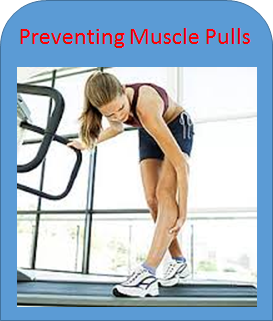
Physical activity can cause muscle overstretching, known as a strained or pulled muscle. The result is normally some swelling and pain. These are common injuries that usually require no medical attention, although sometimes that is necessary after all. Here, you’ll find how to prevent a pulled muscle, treat it, and if you should seek medical assistance.
Prevention
1. Warm ups.
An overstrained muscle causes it to become a pulled muscle and that can occur if you have not properly worked out before exerting yourself. Make sure you take time stretching so your muscles are ready.
Jog a little before sprinting or running for speed. Play catch, jog, or try light calisthenics when preparing for team sports.
2. Strength Training.
Weightlifting as well as other strength training in your exercising routine may prevent a pulled muscle. You can use weights at home or enter the weight room at your trainer’s studio and give yourself a strong, solid core while keeping your muscles limber.
3. Know Your Limit.
“No pain, no gain” isn’t always correct. When an arm or leg is really beginning to hurt, then stop. Putting even more strain onto a pulled muscle only makes it worse. You could cause deeper tearing which may cause you a full season, instead of a single game.
Treatment
1. Rest Your Muscle.
If it’s strained, stop doing what you were doing. A pulled muscle is really a tear in muscle fibers. You don’t want to continue tearing this more or it can lead to serious injuries.
Your feelings are your guide. A pulled muscle that causes you to need to catch your breath because of severe pain is a strong indicator that you need to sit out and stop what you’re doing. Take a few days off and let your muscles recover.
2. Put Ice On It.
Placing ice on the pulled muscle will reduce swelling as well as the pain. Use a bag of frozen peas or a sealable bag with ice cubes in it. Don’t put direct ice on your skin or you may damage that skin. Instead, wrap a thin towel around the bag. Place the pack of ice on the pulled muscle for about 20 minutes at a time, throughout the day, until swelling has subsided.
Avoid using heat.
3. Compress your muscle.
Wrap up the sore muscle to reduce inflammation while providing extra support in preventing more injury. Don’t wrap it too tight, you don’t want to cut off circulation.
Use a roll of gauze bandage wrap or cut a pillowcase into a long strip.
4. Elevate it.
Lifting the pulled muscle will help reduce swelling while giving it the rest it requires to heal.
Rest your leg on a chair or ottoman when you’re sitting, or for a pulled muscle in the arm, use a sling.
Seek Medical Assistance
1. Keep Track Of Your Pain.
If the treatment above does not heal your pulled muscle in a few days and your pain is still severe, contact your doctor. You might have a more severe injury.
A doctor may supply you with a sling or crutches, and prescription-strength painkillers. If the injury is extreme, the doctor may recommend physical therapy or surgery.
2. Related Symptoms Require A Doctor.
Muscle pain may be related to other things besides being overexerted. It may feel like a pulled muscle but keep an eye open for these symptoms, and see a doctor if they occur:
Infections such as red, raised skin or itchiness
Bite marks where it is sore
Numbness or poor circulation where the pain is felt
3. Severe Symptoms Require A Doctor.
Go directly to the ER or an immediate care center if your sore muscle also has any one of the following severe symptoms:
Extremely weak feeling muscles
Dizziness or shortness in breath
Fever or a stiff neck
Sign Up For Your FREE Trial Today
RECOMMENDED POSTS: